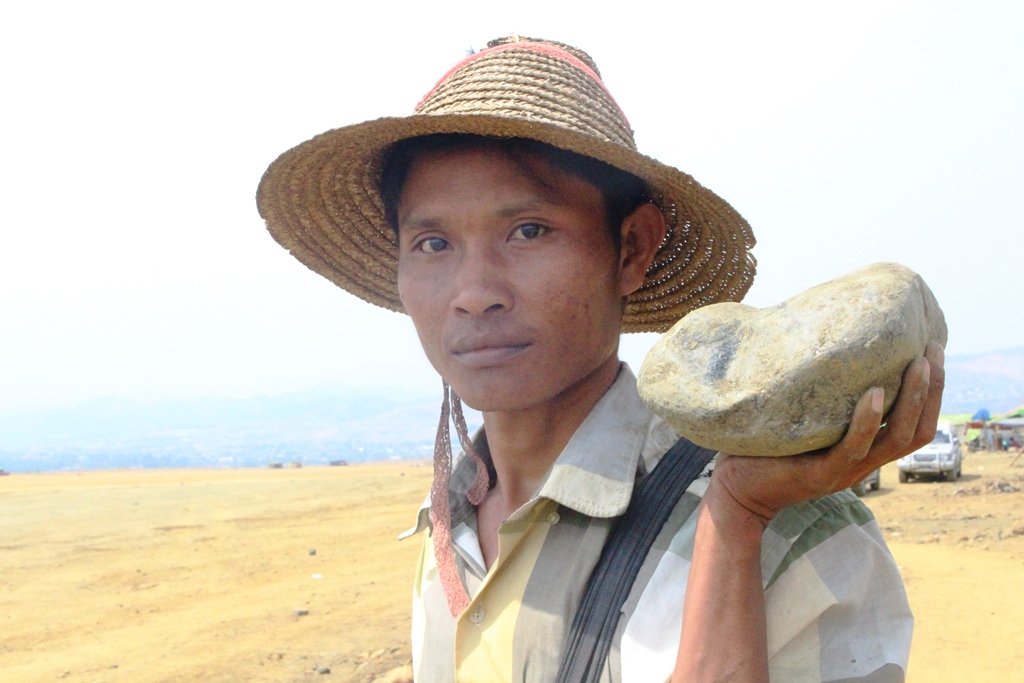For much of the past two decades Maung Aye’s life has revolved around a daily routine that mixes the hope of finding sudden riches with constant danger and back-breaking work.
Every morning, the 36-year-old jade labourer gets up in the bamboo shack that he shares with other workers and walks down from the heap of mining waste on which it sits.
He goes down into one of the many mining pits that scar Hpakant’s mountains and takes out a small hammer mounted on a stick. One by one he taps rocks in the rubble dumped by mining companies, carefully listening to see if the sound could indicate precious jade inside.
At the end of a recent hot April day, he returned to his miners’ camp with a rock half the size of a football, which he inspected with a special flashlight and valued it as low-grade jade worth around 30,000 kyat (around US$26).
“To get good quality jade depends on luck. Sometimes it is hard to find a jade stone worth 10,000 kyat in a week,” said Maung Aye, thin and muscular, wearing a traditional bamboo hat and shorts.
Though the money made in treacherous jade scavenging might seem small to some, it represents a good income to the tens of thousands of men who migrated here from poor, rural communities across Burma.
“Life is too hard for us in our home village, we can’t earn enough income, while we can easily get 5,000 to 10,000 kyat per day here,” said Maung Aye, who left his family home in Magwe Division’s Gangaw Township in central Burma in 1996.
He recalled how he decided to go to Hpakant after fighting with his father. “At the time, I told my mother: I don’t want to live in this house, please give me money and I will go away. She gave me 25 kyat,” he said, adding that he followed his older brother who was already working at the mines.
According to a recent state-run media report, there are some 300,000 men like Maung Aye toiling in the jade mines in northern Burma’s Kachin State.
Local journalists and activists said the numbers of men who migrated here has probably doubled since 2010, perhaps because stories of jade-mining opportunities have spread more easily to remote communities in recent years as mobile phones and Internet connectivity have become more widely available.
An increase in large-scale mining by companies using dynamite and heavy machinery has also increased the amount of rubble available for scavenging.
Those who own the companies that dump the waste on which Maung Aye and many like him live make enormous, unregistered profits. Burma’s opaque jade mining industry has been estimated by resource corruption watchdog Global Witness to be worth up to US$31 billion per year and is controlled by hidden license holders mostly linked to the military elite.
Dangers and dreams of fortunes
The migrant miners are aware of the risks they take by working and sleeping near unstable piles of waste. These are dumped by companies that have little regard for largely unenforced safety regulations. The new National League for Democracy government has pledged to improve safety in Hpakant.
Maung Aye is stoical about the dangers and confident he can stay safe after many years in the mines. “I have got a lot of experience and know how to keep away from the falling waste, I was never injured,” he said.
Deadly accidents are a regular occurrence. A night-time landslide last November buried 114 migrant miners, according to the official death toll. Several accidents have killed groups of workers since then. Most recently, on 23 May, at least 13 miners died when a pit collapsed.
Maung Aye said the November accident occurred near his camp and he saw the aftermath, adding that the number of deaths was probably several times higher than official figures as authorities had stopped searching for buried corpses after two days.
“Scavengers and machinery drivers from mining companies died, maybe 300 in total, under waste dumped near the site of Mya Ya Mone Company,” he said.
The poor men are willing to face such deadly risks as many dream of finding a large, valuable jade stone that will lift them out of poverty.
Maung Aye got his break in 2002, making a small fortune by Burmese standards when he and his friends found a jade boulder worth around $7,000.
Maung Aye said the gem find turned his life around and he went back to his home village to enjoy his newfound riches and to kick a drug habit he had developed a few months before. Heroin and opium are easily available and used by many workers.
[related]
“I was so happy at home as I could save and bring a certain amount of money for my family. I drank alcohol almost every day with my friends and forgot about the [withdrawal symptoms] I got from quitting drugs,” he said.
Yet, he struggled to use his savings to set up a profitable business in his impoverished village and after eight years at home he returned to Hpakant. He now plans to stay until he feels he has enough income.
“I feel life is more meaningful here than in my village. I can expect to make a lot of money. This is our dream as scavengers,” Maung Aye said. “I can send money to my family and stay here with friends — but I am lonely.”
This article was originally published by Myanmar Now on 25 May 2016.



